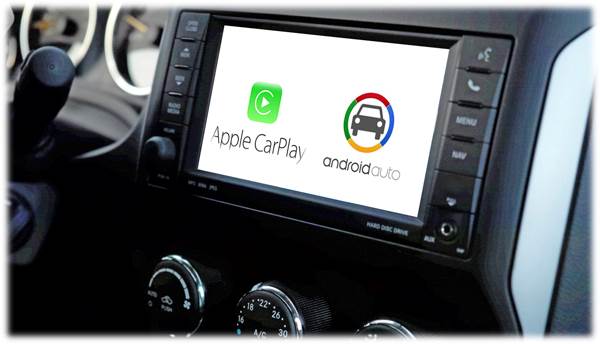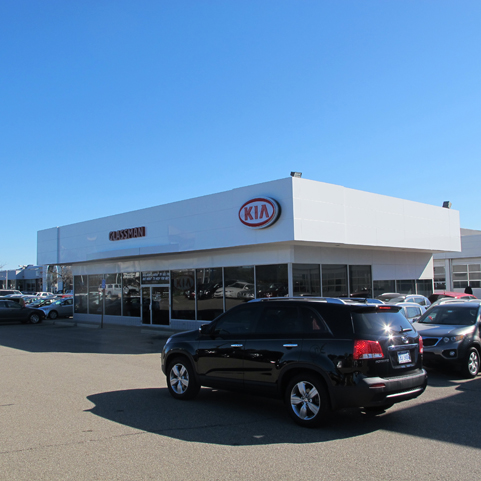Since we launched jācapps nearly eight years ago, it’s been an exciting tumultuous ride in the mobile app space. We’ve come a long way  since those early iPhone apps. Back then, the Android platform didn’t even exist.
since those early iPhone apps. Back then, the Android platform didn’t even exist.
And over the years, we’ve watched the smartphone invade the automotive arena. That industry has invested billions in dashboard technology, experimenting with embedded apps on the touchscreen, as well as making it even more seamless to import smartphone apps via phone pairing.
Our company’s DASH Conferences have been designed to bridge the gap between the radio and automotive industries. It’s a tricky space because every OEM (auto manufacturer) has developed its own dashboard ecosystem. Along the way, we’ve learned a lot about the challenges facing the auto industry as it dives headlong into the world of the connected car, and what it means to radio broadcasters.
Enter Google and Apple, dashboard invaders that are transforming the in-car media experience. To help us better understand why these systems are worthy of radio’s attention, I asked Bob Kernen, jācapps’ COO, to give us the guided tour of dashboards in the Apple/Google era. Here’s Bob’s report, along with a checklist of things your station can do. – FJ

In case you missed our announcement earlier this summer, jācapps is now offering our radio apps with integration into Apple’s CarPlay and Google’s Android Auto. As a company that lives down the hall from the connected car thought leaders at Jacobs Media, this has been a great tech adventure for us. Now that our first app for WMMR/Philadelphia is out in the connected car ecosphere, I took the opportunity to venture out and “test drive” these two dashboard platforms in a variety of cars to truly experience this new technology.
If you haven’t checked out the Apple or Android in-dash reality, here’s the story. Connected cars on the market today have a touchscreen that serves as the car’s “control panel.” Each auto manufacturer has developed their own software system and user interface, but their quality, usability, and reliability vary wildly.
And because of the lack of standardization across all these different automotive platforms, both Apple and Google have created their own software “layer” that allows the car’s native system to be overridden by an extension of your smartphone’s operating system. Apple’s is known as CarPlay and is rolling out across more than 30 different manufacturers. Google’s is Android Auto and it will soon have presence in more than 50 brands.
If your new car’s in-dash system supports one or both of these platforms, you can bring your phone into the car and “connect,” accessing certain functions and apps from your phone on the car’s touchscreen. Once connected, you can make calls, send and retrieve text messages and audio content – including our radio station apps. It’s a terrific concept: your phone is truly “synced” to your car.
Not every app in your phone ports over to the dashboard touchscreen. And that where jācapps comes into play. We’ve spent the better part of the last year working through software developer kits (as well as many other hoops) perfecting the code that lets us adapt our apps to both these dashboard systems. In this way, any radio station’s app can live right alongside Pandora, Spotify, and other media entertainment apps that have passed muster for Android and Apple.
Of course, the apps work just fine on our “emulators,” the test systems that ape your dashboard. But the key is making sure they perfrom in the field – in all the vehicles that support both Apple CarPlay and Android Auto.
This time around, it was still a little dicey because most auto manufacturers have only begun rolling out CarPlay and Android Auto. It’s not featured in every model, or even in every option package. Typically, you have to purchase or lease the top-end in-car navigation and entertainment system to get CarPlay or Android Auto.
But the salespeople we encountered at multiple dealerships are far more knowledgeable now. They knew these systems, how to connect them,

and which cars offer the option. That suggests that when consumers walk into showrooms this fall, their experience will be more informed and useful to new car buyers. And chances are, if they are avid smartphone users, they will quickly understand why these systems are so attractive in dashboards.
With both systems, connecting was easy – just plug in your phone and select the CarPlay or Android Auto option. Once connected, I have to admit it was instantly a game-changer – for both good and not-so-good reasons.
Suddenly, your car is an extension of your iPhone or Android smartphone. The media, messaging and mapping choices in your phone show up in your dashboard, sporting the same familiar look and icons you’re used to on your smartphone. Connecting is smooth and easy – practically seamless. The downside is that interacting with other features of your car, like the temperature control and the radio can get a little more complicated.
But if you’re someone who drives different cars from time to time, having the same in-dash experience no matter which vehicle you’re driving is fantastic. It’s easy to imagine how convenient this will be when more rental cars have CarPlay or Android Auto. No matter which car they give you, you’ll just hop in, connect, and you’re good to go.
As mobile phones have become the essential Swiss Army Knife of modern life, it’s inevitable that we will want other technology systems in our life to integrate easily and intuitively with our phone (the label “phone” seems woefully insufficient). So the car is here now, and reports from both Apple and Google indicate that your house is next as both companies are busy creating operating systems for that environment.
That’s part of the larger concept of the Internet of Things which Fred has blogged about earlier this year, after he and Paul made the trek to Vegas for CES.
Here are a few thought-starters and ideas about Apple CarPlay and Android Auto:
- Take a test drive. As I learned, you can stroll into a car dealership with an Apple or Android phone, ask about these platforms, and quickly connect. See how your phone “looks” in the dashboard and how easy it is to make the connection.
- Picture where radio fits in. Once you get beyond the native apps (text, maps, etc.), check out the music-centric apps like Pandora. Imagine what it would be like if your station’s app appeared on the same touchscreen. Now look for how you’d find and tune in your radio station when it’s not a part of the Apple and/or Android system. This exercise is precisely the challenges radio will face when drivers use these platforms.
- Assess your content and how it stacks up. This is the tricky part because it has little to do with technology, and a lot to do with programming strategy. When your station is competing against “everyone,” what parts of your content make you special, unique, different, and useful? It could be your personalities, your community presence, your unique music, or maybe something else. This is all about radio’s strategic challenge in cars.
- Check out the voice commands. Whether it’s Siri or the Android voice, see how drivers will be able to connect with their content while behind the wheel. This is where it’s headed.
- Don’t tell the salesperson you’re in radio. Pay close attention to how that showroom rep discusses the dash, specifically the Android and Apple systems. What are the features they’re pitching? If radio doesn’t come up, bring it up, and assess where the medium stands in the hierarchy of the salesperson’s importance. This is something I paid attention to, and you should, too.
The “center stack,” as the automakers call it, continues to evolve. As every automaker has invested millions of money into their proprietary systems, the Apple and Android platforms appear to be positioned to change the game.
Local dealerships aren’t just the lifeblood of the sales department. They are conduits to in-car listening for your audience and the new cars they buy or lease.
This is the next stop in radio’s changing relationship with the car.
To discuss how the mobile revolution – especially Apple CarPlay and Android Auto – will affect your business now and in the future, give us a call at 248-353-9030, or email us at [email protected].
Understanding the Connected Car Webinar
Fred Jacobs recently hosted a webinar called “Understanding the Connected Car: An Introduction for Radio Broadcasters.”
- 7 Lessons We’ve Learned From Developing 1,300 Mobile Apps - February 5, 2020
- Mobile Christmas & Appy Chanukah Wishes - December 13, 2016
- Apple CarPlay and Android Auto In The Wild - August 31, 2016




Leave a Reply